Page 34 of 104
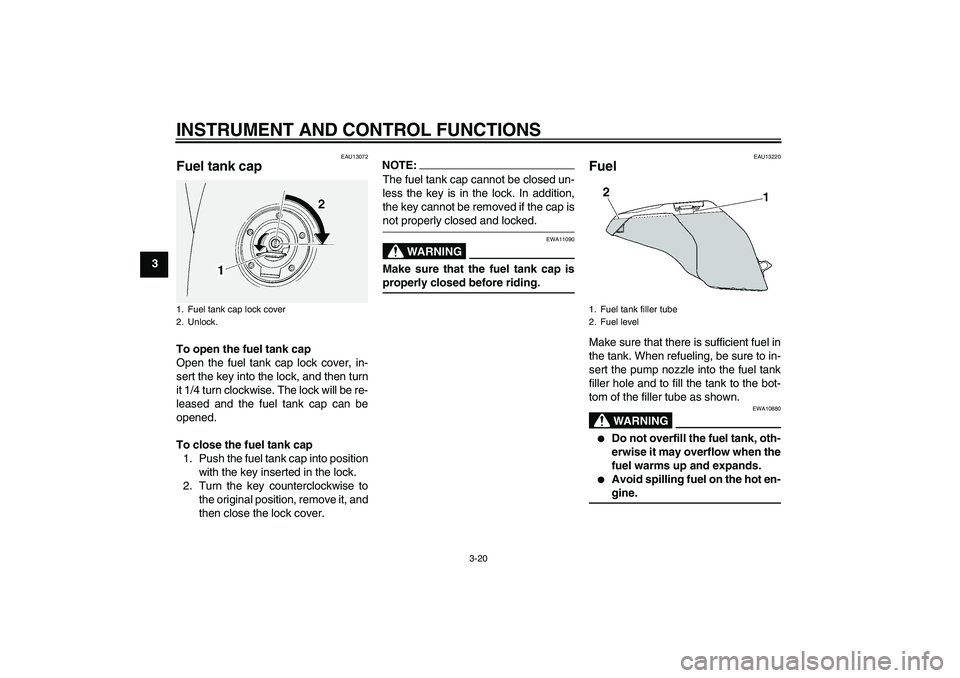
INSTRUMENT AND CONTROL FUNCTIONS
3-20
3
EAU13072
Fuel tank cap To open the fuel tank cap
Open the fuel tank cap lock cover, in-
sert the key into the lock, and then turn
it 1/4 turn clockwise. The lock will be re-
leased and the fuel tank cap can be
opened.
To close the fuel tank cap
1. Push the fuel tank cap into position
with the key inserted in the lock.
2. Turn the key counterclockwise to
the original position, remove it, and
then close the lock cover.
NOTE:The fuel tank cap cannot be closed un-
less the key is in the lock. In addition,
the key cannot be removed if the cap isnot properly closed and locked.
WARNING
EWA11090
Make sure that the fuel tank cap isproperly closed before riding.
EAU13220
Fuel Make sure that there is sufficient fuel in
the tank. When refueling, be sure to in-
sert the pump nozzle into the fuel tank
filler hole and to fill the tank to the bot-
tom of the filler tube as shown.
WARNING
EWA10880
�
Do not overfill the fuel tank, oth-
erwise it may overflow when the
fuel warms up and expands.
�
Avoid spilling fuel on the hot en-gine.
1. Fuel tank cap lock cover
2. Unlock.
1. Fuel tank filler tube
2. Fuel level
U2D2E2E0.book Page 20 Thursday, October 11, 2007 9:15 AM
Page 35 of 104

INSTRUMENT AND CONTROL FUNCTIONS
3-21
3
CAUTION:
ECA10070
Immediately wipe off spilled fuel
with a clean, dry, soft cloth, since
fuel may deteriorate painted surfac-es or plastic parts.
EAU13320
CAUTION:
ECA11400
Use only unleaded gasoline. The use
of leaded gasoline will cause severe
damage to internal engine parts,
such as the valves and piston rings,as well as to the exhaust system.
Your Yamaha engine has been de-
signed to use regular unleaded gaso-
line with a research octane number of
91 or higher. If knocking (or pinging) oc-
curs, use a gasoline of a different brandor premium unleaded fuel. Use of un-
leaded fuel will extend spark plug life
and reduce maintenance costs.
EAU39450
Fuel tank breather/overflow
hose Before operating the motorcycle:�
Check the fuel tank breather/over-
flow hose connection.
�
Check the fuel tank breather/over-
flow hose for cracks or damage,
and replace it if damaged.
�
Make sure that the end of the fuel
tank breather/overflow hose is not
blocked, and clean it if necessary.
Recommended fuel:
REGULAR UNLEADED GASOLINE
ONLY
Fuel tank capacity:
25.0 L (6.61 US gal) (5.50 Imp.gal)
Fuel reserve amount:
5.5 L (1.45 US gal) (1.21 Imp.gal)
1. Fuel tank breather/overflow hose
U2D2E2E0.book Page 21 Thursday, October 11, 2007 9:15 AM
Page 36 of 104
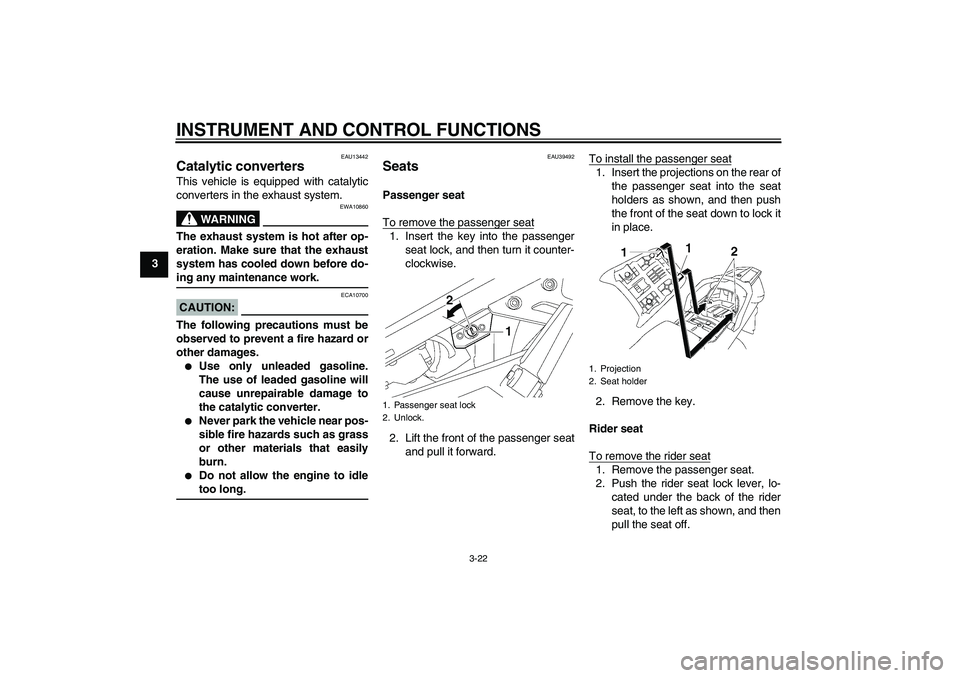
INSTRUMENT AND CONTROL FUNCTIONS
3-22
3
EAU13442
Catalytic converters This vehicle is equipped with catalytic
converters in the exhaust system.
WARNING
EWA10860
The exhaust system is hot after op-
eration. Make sure that the exhaust
system has cooled down before do-ing any maintenance work.CAUTION:
ECA10700
The following precautions must be
observed to prevent a fire hazard or
other damages.�
Use only unleaded gasoline.
The use of leaded gasoline will
cause unrepairable damage to
the catalytic converter.
�
Never park the vehicle near pos-
sible fire hazards such as grass
or other materials that easily
burn.
�
Do not allow the engine to idletoo long.
EAU39492
Seats Passenger seat
To remove the passenger seat1. Insert the key into the passenger
seat lock, and then turn it counter-
clockwise.
2. Lift the front of the passenger seat
and pull it forward.To install the passenger seat
1. Insert the projections on the rear of
the passenger seat into the seat
holders as shown, and then push
the front of the seat down to lock it
in place.
2. Remove the key.
Rider seat
To remove the rider seat1. Remove the passenger seat.
2. Push the rider seat lock lever, lo-
cated under the back of the rider
seat, to the left as shown, and then
pull the seat off.
1. Passenger seat lock
2. Unlock.
1. Projection
2. Seat holder
U2D2E2E0.book Page 22 Thursday, October 11, 2007 9:15 AM
Page 37 of 104
INSTRUMENT AND CONTROL FUNCTIONS
3-23
3
To install the rider seat
1. Insert the projection on the front of
the rider seat into the seat holder
as shown, and then push the rear
of the seat down to lock it in place.2. Install the passenger seat.
NOTE:�
Make sure that the seats are prop-
erly secured before riding.
�
The rider seat height can be ad-
justed to change the riding posi-tion. (See page 3-23.)
EAU39632
Adjusting the rider seat height The rider seat height can be adjusted to
one of two positions to suit the rider’s
preference.
The rider seat height was adjusted to
the lower position at delivery.
To change the rider seat height to
the high position
1. Remove the rider seat. (See page
3-22.)
2. Remove the rider seat height posi-
tion adjuster by pulling it upward.
1. Rider seat lock lever
2. Rider seat
1. Projection
2. Seat holder
1. Low position
2. High position
U2D2E2E0.book Page 23 Thursday, October 11, 2007 9:15 AM
Page 38 of 104
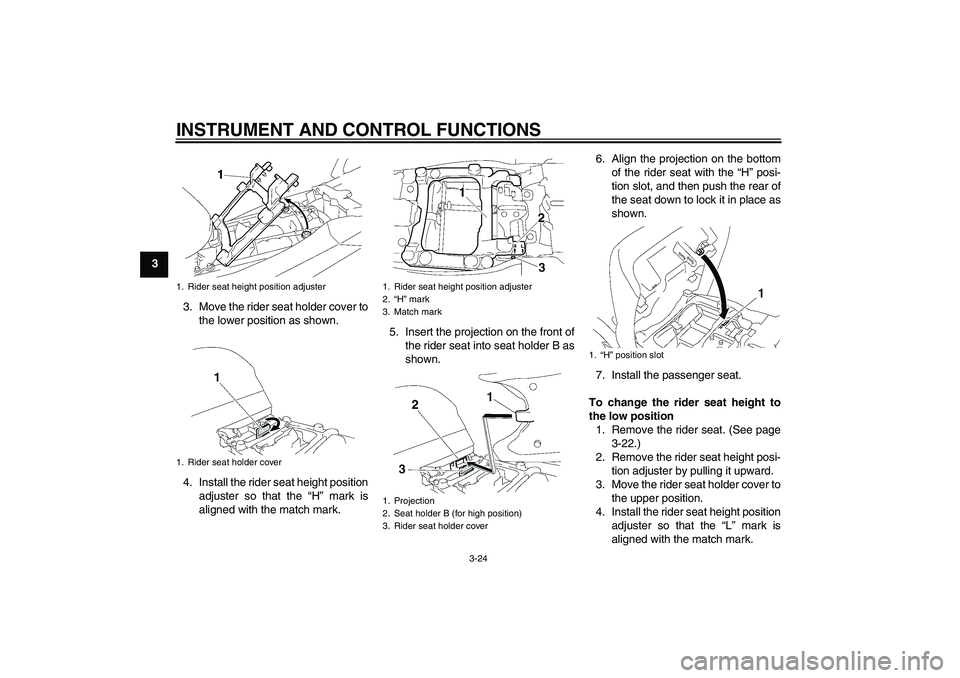
INSTRUMENT AND CONTROL FUNCTIONS
3-24
3
3. Move the rider seat holder cover to
the lower position as shown.
4. Install the rider seat height position
adjuster so that the “H” mark is
aligned with the match mark.5. Insert the projection on the front of
the rider seat into seat holder B as
shown.6. Align the projection on the bottom
of the rider seat with the “H” posi-
tion slot, and then push the rear of
the seat down to lock it in place as
shown.
7. Install the passenger seat.
To change the rider seat height to
the low position
1. Remove the rider seat. (See page
3-22.)
2. Remove the rider seat height posi-
tion adjuster by pulling it upward.
3. Move the rider seat holder cover to
the upper position.
4. Install the rider seat height position
adjuster so that the “L” mark is
aligned with the match mark.
1. Rider seat height position adjuster
1. Rider seat holder cover
1. Rider seat height position adjuster
2.“H” mark
3. Match mark
1. Projection
2. Seat holder B (for high position)
3. Rider seat holder cover
1.“H” position slot
U2D2E2E0.book Page 24 Thursday, October 11, 2007 9:15 AM
Page 39 of 104
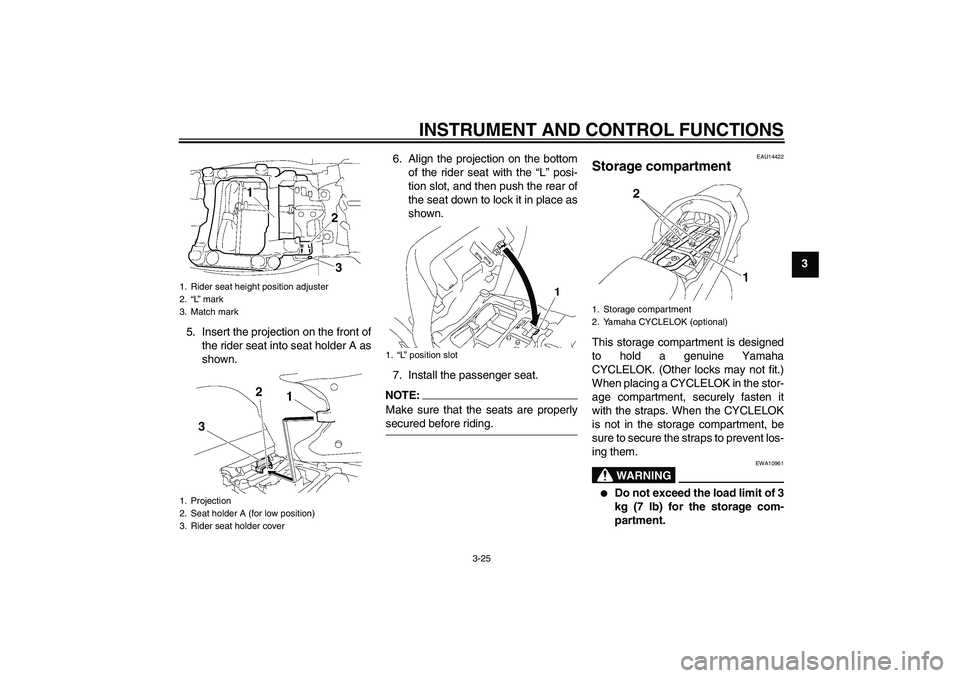
INSTRUMENT AND CONTROL FUNCTIONS
3-25
3
5. Insert the projection on the front of
the rider seat into seat holder A as
shown.6. Align the projection on the bottom
of the rider seat with the “L” posi-
tion slot, and then push the rear of
the seat down to lock it in place as
shown.
7. Install the passenger seat.
NOTE:
Make sure that the seats are properlysecured before riding.
EAU14422
Storage compartment This storage compartment is designed
to hold a genuine Yamaha
CYCLELOK. (Other locks may not fit.)
When placing a CYCLELOK in the stor-
age compartment, securely fasten it
with the straps. When the CYCLELOK
is not in the storage compartment, be
sure to secure the straps to prevent los-
ing them.
WARNING
EWA10961
�
Do not exceed the load limit of 3
kg (7 lb) for the storage com-
partment.
1. Rider seat height position adjuster
2.“L” mark
3. Match mark
1. Projection
2. Seat holder A (for low position)
3. Rider seat holder cover
1.“L” position slot
1. Storage compartment
2. Yamaha CYCLELOK (optional)
U2D2E2E0.book Page 25 Thursday, October 11, 2007 9:15 AM
Page 79 of 104
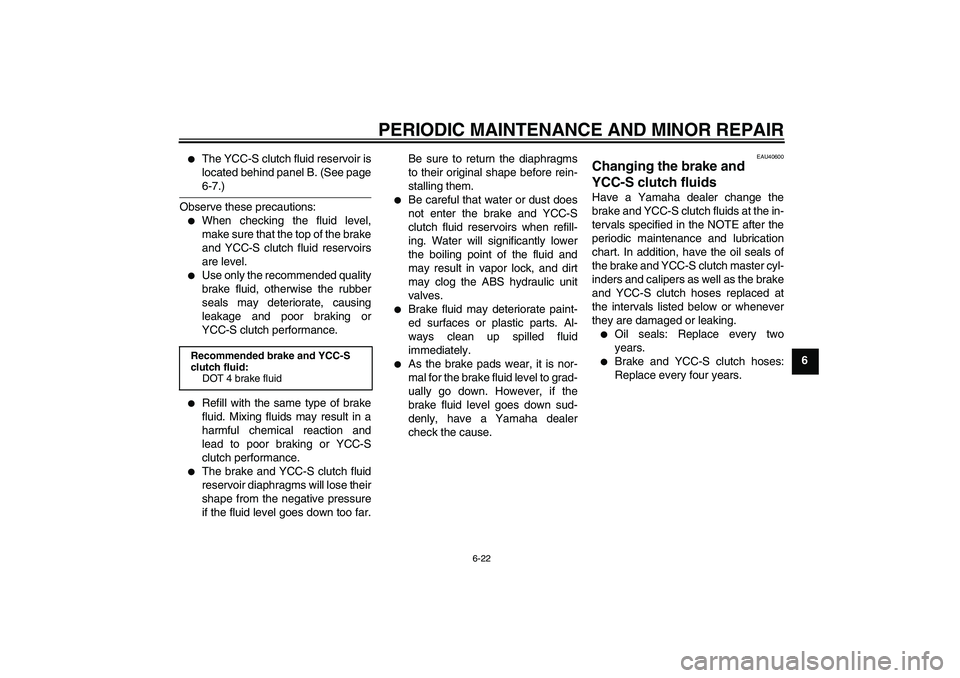
PERIODIC MAINTENANCE AND MINOR REPAIR
6-22
6
�
The YCC-S clutch fluid reservoir is
located behind panel B. (See page6-7.)
Observe these precautions:
�
When checking the fluid level,
make sure that the top of the brake
and YCC-S clutch fluid reservoirs
are level.
�
Use only the recommended quality
brake fluid, otherwise the rubber
seals may deteriorate, causing
leakage and poor braking or
YCC-S clutch performance.
�
Refill with the same type of brake
fluid. Mixing fluids may result in a
harmful chemical reaction and
lead to poor braking or YCC-S
clutch performance.
�
The brake and YCC-S clutch fluid
reservoir diaphragms will lose their
shape from the negative pressure
if the fluid level goes down too far.Be sure to return the diaphragms
to their original shape before rein-
stalling them.
�
Be careful that water or dust does
not enter the brake and YCC-S
clutch fluid reservoirs when refill-
ing. Water will significantly lower
the boiling point of the fluid and
may result in vapor lock, and dirt
may clog the ABS hydraulic unit
valves.
�
Brake fluid may deteriorate paint-
ed surfaces or plastic parts. Al-
ways clean up spilled fluid
immediately.
�
As the brake pads wear, it is nor-
mal for the brake fluid level to grad-
ually go down. However, if the
brake fluid level goes down sud-
denly, have a Yamaha dealer
check the cause.
EAU40600
Changing the brake and
YCC-S clutch fluids Have a Yamaha dealer change the
brake and YCC-S clutch fluids at the in-
tervals specified in the NOTE after the
periodic maintenance and lubrication
chart. In addition, have the oil seals of
the brake and YCC-S clutch master cyl-
inders and calipers as well as the brake
and YCC-S clutch hoses replaced at
the intervals listed below or whenever
they are damaged or leaking.�
Oil seals: Replace every two
years.
�
Brake and YCC-S clutch hoses:
Replace every four years.
Recommended brake and YCC-S
clutch fluid:
DOT 4 brake fluid
U2D2E2E0.book Page 22 Thursday, October 11, 2007 9:15 AM
Page 86 of 104

PERIODIC MAINTENANCE AND MINOR REPAIR
6-29
6
If a fuse is blown, replace it as follows.
1. Turn the key to “OFF” and turn off
the electrical circuit in question.2. Remove the blown fuse, and then
install a new fuse of the specified
amperage.
CAUTION:
ECA10640
Do not use a fuse of a higher amper-
age rating than recommended to
avoid causing extensive damage to
the electrical system and possibly afire.
3. Turn the key to “ON” and turn on
the electrical circuit in question to
check if the device operates.
4. If the fuse immediately blows
again, have a Yamaha dealer
check the electrical system.
1. Fuse box
2. Right radiator fan fuse
3. Left radiator fan fuse
4. Hazard fuse
5. Backup fuse (for odometer, clock and immo-
bilizer system)
6. ABS solenoid fuse
7. Fuel injection system fuse
8. Headlight fuse
9. Signaling system fuse
10.ABS control unit fuse
11.Ignition fuse
12.Auxiliary DC jack fuse
13.YCC-S motor control fuse
14.Spare fuse
20
0
2
714
8 9
10 11
12 13
Specified fuses:
Main fuse:
50.0 A
Headlight fuse:
25.0 A
Signaling system fuse:
15.0 A
Ignition fuse:
10.0 A
Radiator fan fuse:
15.0 A × 2
Backup fuse:
10.0 A
Hazard fuse:
10.0 A
Fuel injection system fuse:
15.0 A
ABS solenoid fuse:
20.0 A
ABS control unit fuse:
10.0 A
Auxiliary DC jack fuse:
3.0 A
ABS motor fuse:
30.0 A
YCC-S motor control fuse:
30.0 A
U2D2E2E0.book Page 29 Thursday, October 11, 2007 9:15 AM